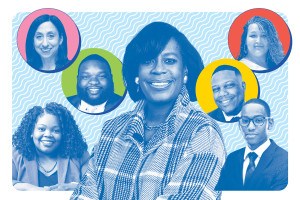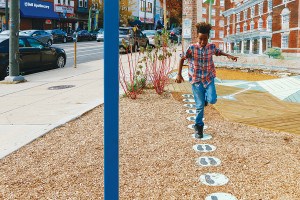Why I Hope You Won’t Read “Being White in Philly”
Exactly what constitutes racism is a matter of debate. But my own sense is that racism takes many forms and one is a preoccupation with race—seeing skin color before the person, or wrongly assuming a person’s race to be a primary cause of their behavior. I believe the story “Being White in Philly,” in the March issue of Philadelphia Magazine, is guilty of these forms of racism. And this isn’t an assessment I make with any pleasure.
The story’s writer, Bob Huber, is a friend and colleague whose work I’ve long respected. His lament, in this piece, is that whites can’t talk about race for fear of being labeled “racist.” And the story’s stated aim is to print the things white people think but are uncomfortable saying. Problems crop up throughout: No African-Americans are interviewed in the piece, nor are any Asians or Latinos; and the narrative takes place in a small swath of land, along the border of Fairmount, a largely white section of the city, and North Philadelphia, which is predominantly African-American. This gives a story that purports to be broad and authoritative a narrow cast. But I’m going to start by focusing on one early exchange, between Bob and a white Russian lady, who cuts loose.
“Blacks use skin color as an excuse,” she says. “Discrimination is an excuse, instead of moving forward. … It’s a shame—you pay taxes, they’re not doing anything except sitting on porches smoking pot … Why do you support them when they won’t work, just making babies and smoking pot?”
There isn’t much done to contextualize this quote. And what’s there seems to endorse the Russian lady’s view. “If you’re not an American, the absence of a historical filter results in a raw view focused strictly on the here and now,” Huber writes, which I interpret as suggesting the foreigner has a clearer-eyed view of the moment.
Bob assures me he just wanted to let his sources speak for themselves in this story. But he seems to miss the obvious here, which is that if white Philadelphians would like to be able to address race without being labeled “racist,” they should avoid saying racist things. But there are further layers of error and creeping bias to uncover here.
The story never really sets itself up properly. For instance, it’s never stated that the writer is going to let his sources say any ‘ole thing. And the resulting piece doesn’t seem to obey even the most basic journalistic conventions—like being true. After all, the city’s African-Americans demonstrably aren’t sitting on their porches, waiting for government checks to arrive. They’re working—the unemployment rate among African-Americans is 14 percent. Perhaps some African-Americans, like some whites, Asians and Latinos, are underemployed or working low-wage jobs but they are not, as a group, smoking weed while they wait for the mail. For sake of comparison, imagine if we had quoted someone leveling the allegation that Ed Rendell is now spending his days sitting on his porch, smoking pot and waiting for financial “support.” We’d bat those falsehoods away with factual information a sentence or two later. But in this instance, an entire race was denigrated without exercising the journalistic practice of being, you know, factual—first taught in high school and reinforced throughout a career.
Now, Bob writes that he wants to see the city begin to engage in a meaningful conversation about race. And I’m sure, with the story now online, a “conversation” will start. I’m going to try and write something here that might render that conversation productive. Because there is a subtler issue at play here—namely, “Being White in Philly” never really raises matters of race.
As the piece winds on, Bob writes about street fights, drug dealing, muggings, the theft of grills and Halloween pumpkins. In each instance, the only feature of the perpetrators he mentions is the (imagined) color of their skin. I say “imagined” because, in some instances there is no witness—just the thought that it must have been a “black guy” or kid acting as the culprit.
Shocked yet?
I sure am.
It is, in my opinion, one thing for some racist resident to feel and think these thoughts, another entirely for a major city magazine to do it—and publish them as fact. What’s missing, among many things, is meaningful analysis.
Do people steal BBQ grills from back patios because they’re black? Or Halloween pumpkins? Do they deal Oxycontin because the amount of pigment in their skin produces such behavior? No. And I’d contend that if this story ever moved beyond its contention that we need to talk about race, to actually thinking about what it is we need to say, Bob might have realized the behaviors that so concern him aren’t related to race but to socioeconomics.
Beginning in the 1970s, U.S. academics started publishing on the link between unemployment, poverty and crime. And over the years, a host of further socioeconomic factors have been shuffled into the equation, including income level, neighborhood quality and education. It is, in fact, patently true that teenagers of every shade steal or crush Halloween pumpkins, everywhere—in quaint Collingswood and citified Fairmount—because they lack impulse control. People spirit grills away, probably to sell or pawn them for cash, because they have poor or zero job prospects.
“The economic motivation behind crime is essentially the appropriation of somebody else’s property,” reads one study published by the World Bank. “Another [factor] is the pursuit of illegal activity even at the risk of being caught and punished. Therefore, criminal offenders are likely to be found among those who have relatively more to gain from these activities and relatively little to lose in case they are caught. Individuals such as these presumably belong to the neediest groups in society … .”
The big challenge, then, in talking about race, may be making sure that race is what we’re actually talking about.
This Philly Mag article, however, never even reaches this level of awareness. Instead, we encounter a litany of anecdotes about blacks and imagined blacks behaving badly. And frankly, nearly a week after I first read this story, I still can’t believe I’m not just making it up.
In a situation like this, my personal pains—the angst of me, the white reporter—aren’t and should not be on the public radar. But before I conclude with what’s really at stake here, I should offer a personal note, just for the record. It’s Bob who edited my story “What Will Happen to Harold?,” in which I wrote about the challenges a 10-year-old African-American boy faces in North Philadelphia. And just this summer, our magazine’s editor, Tom McGrath, helped me pull together this story about how post traumatic stress disorder afflicts thousands of residents in this city’s poorest neighborhoods. In each case, both men edited with intelligence and sensitivity. And I expect they will both do so again.
What happened on this current piece?
Did both men fall off a horse?
I don’t know. But I am both personally and professionally stunned that Tom thought, in his editor’s column, to refer to Bob’s new piece as a “bookend” to my story on PTSD.
In short, it’s not.
Now, it is rare, if not unprecedented, for a city magazine to print a story like Bob’s. And it is rarer still for a writer on staff to be allowed a public forum to question the judgment of the publication for which he works. But here we are.
It is not lost on me that “Being White in Philly,” is (most likely) a transparent attempt to get an emotional reaction, and in that sense I am only feeding the fire I suspect the magazine hoped would start. So let me conclude by saying something even more outrageous: I sincerely hope you will not read Bob’s story. Let me do this service for you. Whoever you are, “Being White in Philly,” is not—in my opinion—worthy of your time.
READ ALSO: Jason Fagone’s “Philly Mag’s ‘Being White in Philly’ Doesn’t Make Sense as Journalism,” and Tom McGrath’s “Why We Wrote About Race.”


